Breastfeeding tips for new moms

If you choose to breastfeed your baby, having the necessary supplies (as well as plenty of support and self-love) can make it more joyful.
Breastfeeding can be a wonderful bonding experience for you and your baby — but it can also come with some challenges. The good news is that millions of moms before you, with the help of medical professionals, have paved the way with breastfeeding tips, resources and nursing products to help make feeding your new baby as easy and enjoyable as possible.*
In this article:
Tips for successful breastfeeding
“There are so many forms of success, and that includes not needing to breastfeed at all,” says Cindy Rubin, MD, IBCLC, a breastfeeding and lactation medicine specialist as well as owner of In Touch Pediatrics and Lactation, PLLC, based in Westchester, Illinois. There are many different ways to meet your baby’s needs. “If breastfeeding is not going as you had planned, reach out early to a breastfeeding professional to get help,” she says.
What’s more, up to one in eight women are estimated to experience postpartum depression, so Dr. Rubin notes that you should be prepared to practice self-care during this transition. “It’s okay to ask for help, and it’s okay to not be ‘perfect,’” she says. During your breastfeeding journey, be flexible, be kind to yourself and, as they say in yoga, give yourself grace to make mistakes and continue on.
Breastfeeding support for new moms
Many women may be told or believe that breastfeeding comes naturally and therefore may feel badly if they have concerns or difficulty. But most women do need more education — and societal help — than they currently receive. Being aware of such nursing challenges and the support for new moms that is available can help you prepare, even during pregnancy.
Your baby’s pediatrician can be an excellent resource for you and can provide tips on breastfeeding successfully. In some cases, the provider may even be an international board-certified lactation consultant (IBCLC), a qualification that can also be held by a nurse, midwife, dietitian or other care professional. Sharifa Glass, MD, IBCLC, founder of The Vine Pediatrics and Lactation in Houston, Texas, recommends assembling a team to help you. “A breastfeeding team should consist of a spouse, partner, family member or friend as well as a pediatrician and a lactation consultant,” says Dr. Glass. “With this team in your corner, you’ll feel more confident and empowered with the knowledge and tools to meet your breastfeeding and pumping goals.”
Your baby’s pediatrician will also likely help you monitor your baby’s weight as you begin to breastfeed. Dr. Rubin explains that breastfed babies can lose between 7 to 10 percent of their birth weight in the first five days of life and then begin to gain it back as they feed. If you are at all concerned about your feeding, talk to your pediatrician or an IBCLC. They can suggest possible supplementation or even different breastfeeding positions to try that can help encourage a better latch and more successful breastfeeding outcomes.
Helpful breastfeeding positions
While some breastfeeding positions are more common than others, Dr. Rubin advises that whichever is the most comfortable for both you and your baby is what you should use. And if you don’t have a nursing pillow — which is recommended for some positions below — there are still ways to make the process more comfortable. “Even just a regular throw pillow can help support your arms while you support your baby,” she adds.
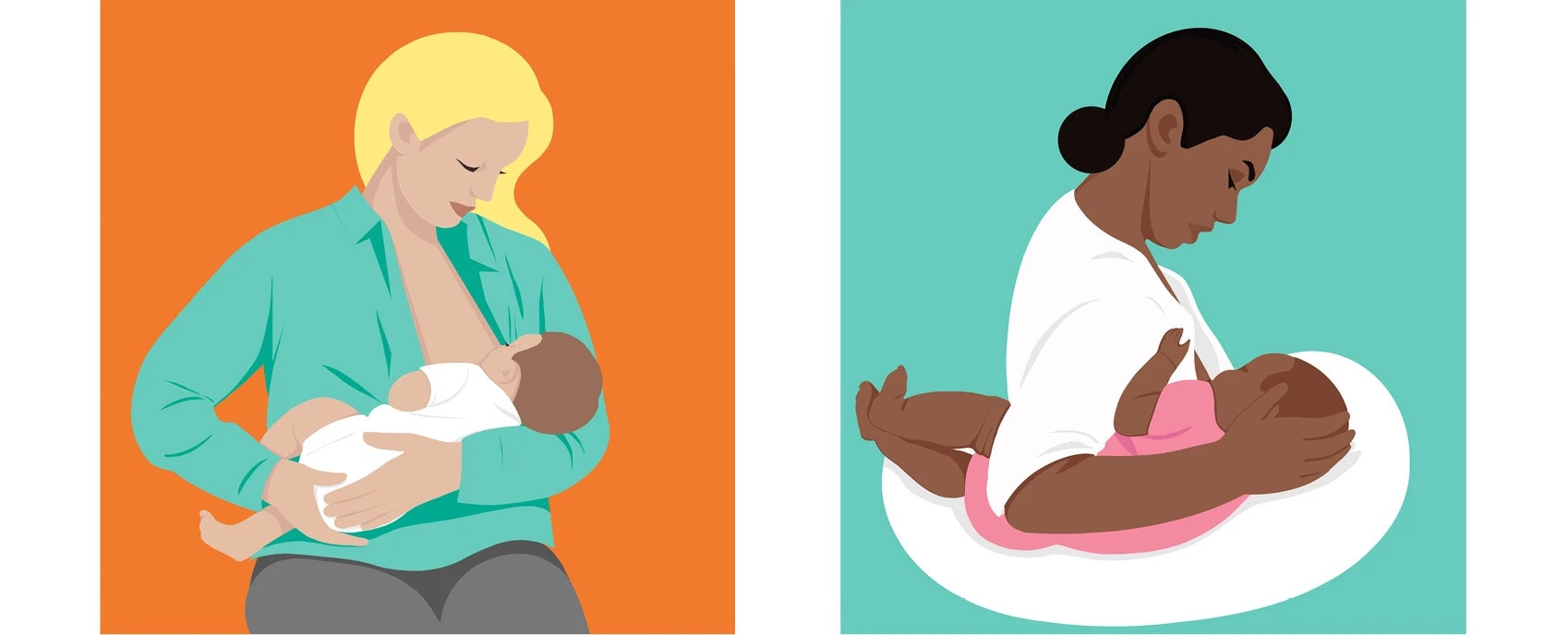
Cradle hold
One of the most common breastfeeding positions is the cradle hold, which has been found to lead to successful breastfeeding. However, if you had a cesarean section (C-section), it may be painful as it puts pressure on the incision. To do cradle hold, the arm you hold your baby with is on the same side as the breast you wish to feed from. For example, if your baby is going to feed from the right breast, you will cradle them so they are laying on their left side across your right forearm, with their head facing toward your armpit and at nipple-level, so they can latch. (see above left)
Clutch or “football” hold
The clutch or football hold can be an excellent choice for mothers who have had a C-section, as it takes the baby off the body. For this hold, place a pillow next to you and support your baby with the arm that is on the same side of the breast you hope to feed from. If feeding from your right breast, you will hold your baby so that they are facing up in your right arm, with their body laying across your arm — feet toward your back — and head up at your breast. (see above right)
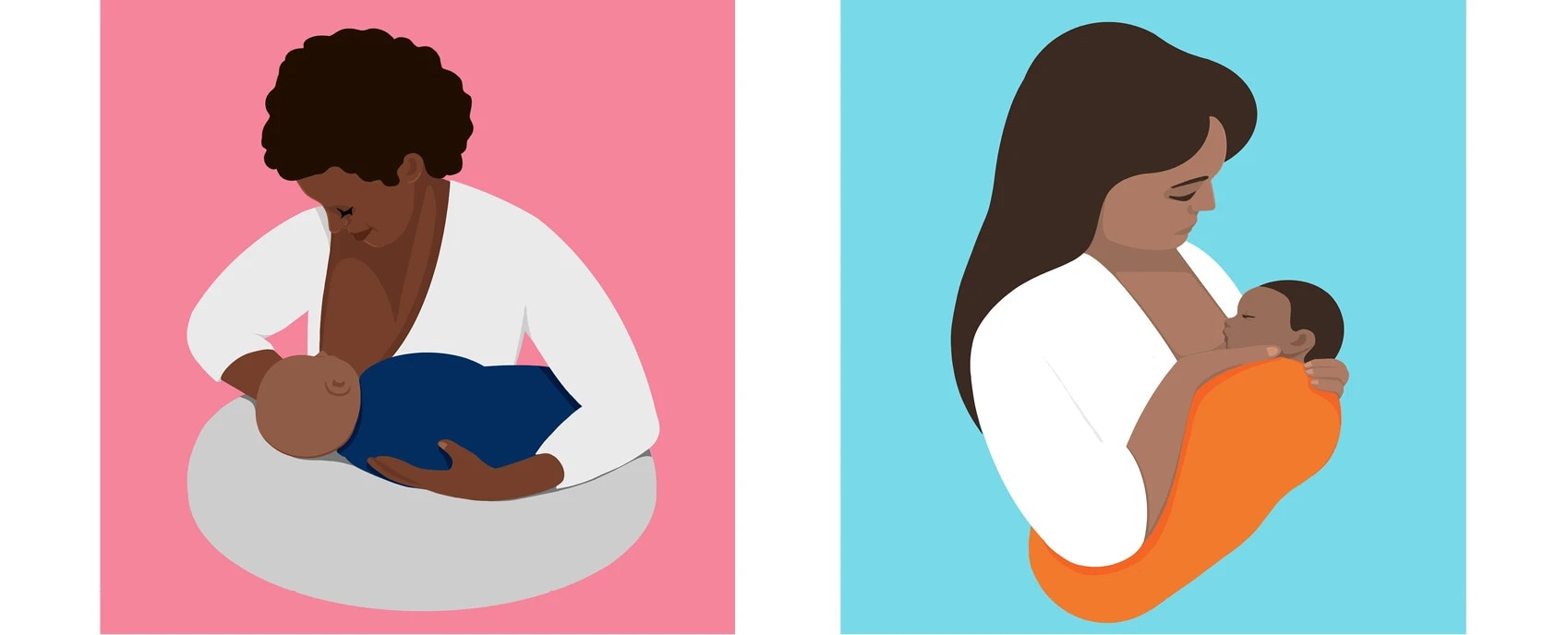
Cross-cradle hold
This breastfeeding position is like the cradle hold, except you hold the baby with your opposite hand. Dr. Rubin notes that this position helps the mom support the baby and see what the baby is doing, as no part of the arm is in the way of the baby’s head. For this position specifically, she recommends the use of a nursing pillow.
“These pillows create something like a ‘baby shelf,’ that really helps keep your baby stable,” explains Dr. Rubin, “and the strap can help to keep both the pillow and baby above any C-section wounds so that the cross-cradle position can be utilized even in women recovering from a C-section.” (see above left)
Dancer hand nursing position
If you are looking for a breastfeeding position that allows you to support both your breast and your baby’s head, you can try the dancer hand nursing position. Your baby is held facing you and your hand is used to support the breast and your child’s head. For example, if you are feeding your baby via the right breast, bring your right hand up and cup the bottom of your right breast using the C-hold, with three of your fingers at the front of the breast. Your thumb and index fingers should be free at this point. Support your baby’s head with the index finger, holding one cheek while the thumb holds the other. This forms a “U” with the baby’s chin resting at the bottom of the “U.” (see above right)
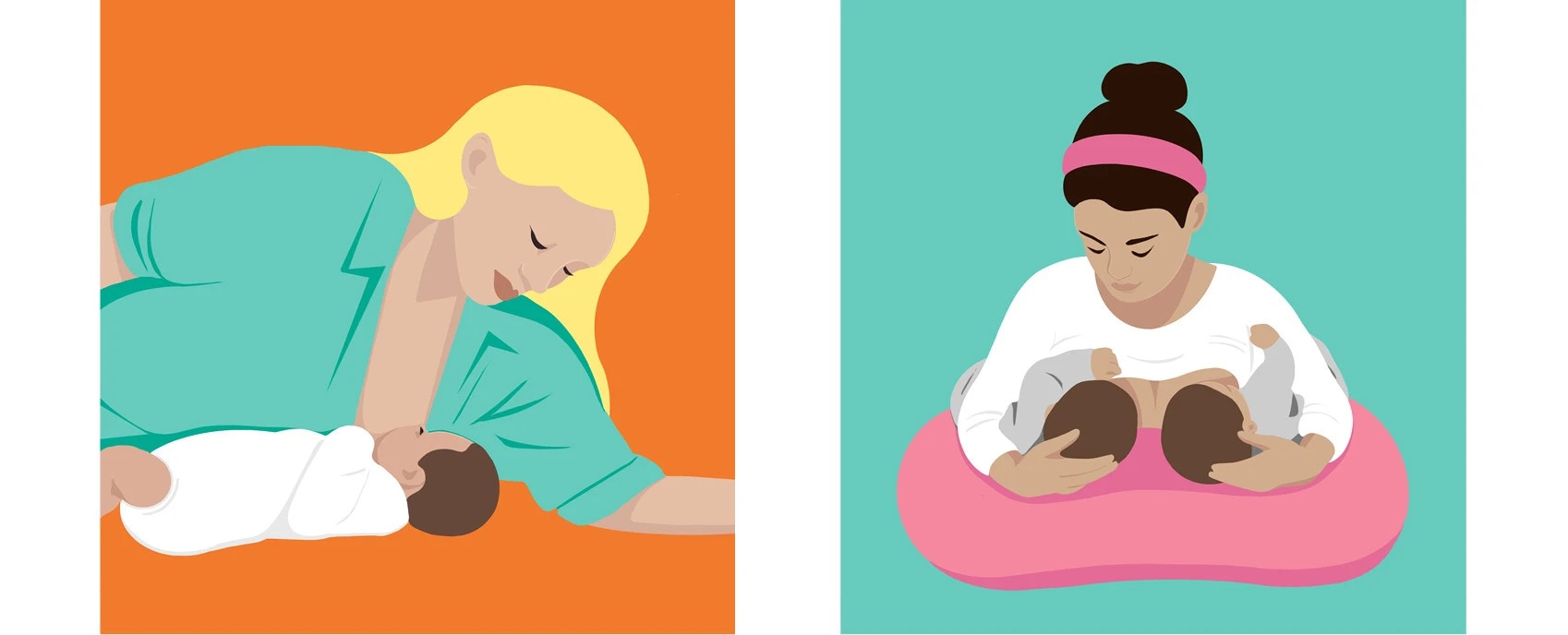
Dangle feeding
For mothers who are experiencing issues with clogged milk ducts, dangle feeding is a recommended option. For this position, your baby is lying flat on their back or elevated on a breastfeeding pillow, while you lean over the baby and dangle your breast above them, guiding the nipple into their mouth. This allows gravity to assist in the emptying of the breast as the baby suckles. (see above left)
Double-clutch or double-football hold
Should you have twins or two babies who are breastfeeding at the same time, the double-clutch hold — or double-football hold — may be a convenient choice. This is simply the football hold done with a baby in each arm, so that they don’t lay across one another and the mother can easily support each child at the same time with the help of pillows. (see above right)
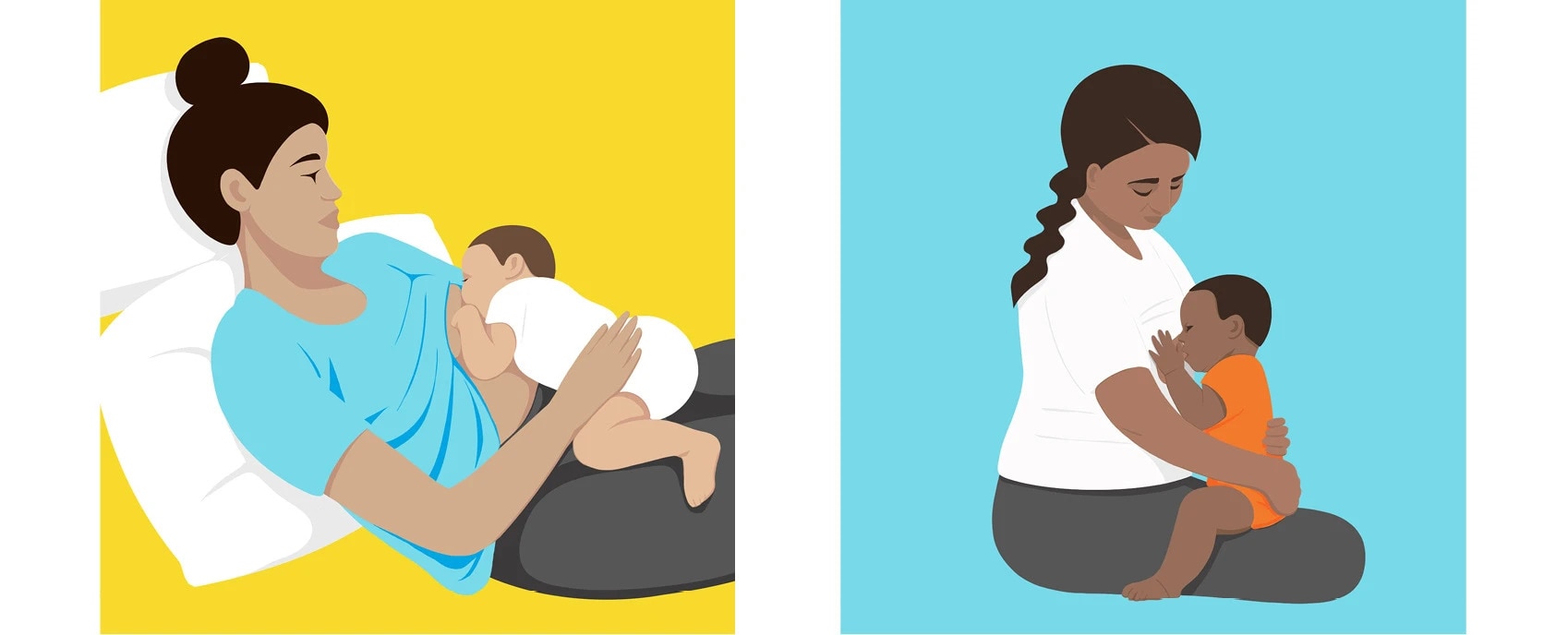
Laid-back breastfeeding or reclined position
Laid-back breastfeeding correlates to the feeding instincts of the baby. In this position, the mother is semi-reclined — think of sitting in a recliner — with the body fully supported, while the baby lays on the mother’s stomach with their cheek resting somewhere near the breast. (see above left)
Upright breastfeeding or koala hold
Feeding your baby while they are upright is suggested to potentially lead to fewer respiratory and ear issues and infections during breastfeeding. Sit up with your back straight and your baby positioned sitting on your lap or straddling one of your legs and facing you, so that their head is breast-height. Also known as koala hold, this mimics how koalas carry their young. (see above right)
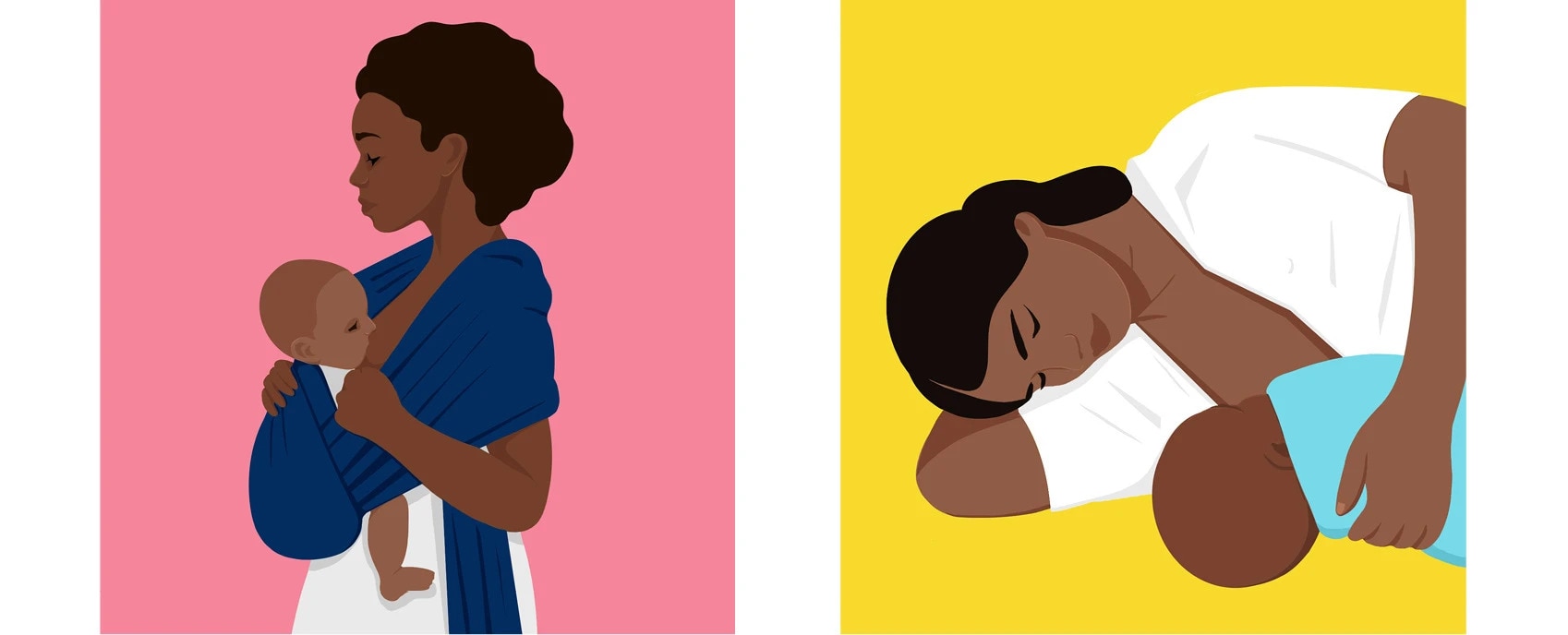
Nursing in a sling
If you’re looking for a way to nurse your baby hands-free, then nursing them while they are in a sling is an option. It is important when choosing a sling to make sure it meets the guidelines of the Consumer Product Safety Commission (CPSC) and, in the early stages of your child’s life, to make sure their head is supported. The CPSC also includes specific safety guidelines for the use of a sling, which include making sure that the face of the infant is visible and uncovered at all times. If the baby is to be nursed in the sling, its position should be changed after the feeding to ensure that the child’s head is facing up and is clear of both the mother’s body and the sling. A child in a sling should be monitored very closely to make sure that its nose and mouth aren’t blocked and its chin is facing away from the wearer’s chest. (see above left)
Side-lying position
In this position, you don’t have to hold your baby, which means that it can be comfortable for women who have had a C-section. For side-lying position, you and your baby both lie on your side facing each other (on a couch or bed) with your baby’s head at breast-height. Dr. Rubin stresses that though this position can be very comfortable, you want to make sure you don’t fall asleep. (see above right)
4 breastfeeding essentials
Pediatrician-approved gear for new parents
Breast pump
Even if you decide to mostly breastfeed, a pump can come in handy if your baby has difficulty latching, you’re separated from your baby for a period of time or you need to stock up on milk.
Breastmilk storage bags
Storage bags are often compatible with breast pumps so that you can pump directly into them. When you’re finished, put them in the fridge or freezer for future use.
Bottles
Having a few bottles with soft, slow-flow nipples can be a great way to give your baby that pumped supply if you’re away and unable to breastfeed them.
Nipple cream
One of the most common breastfeeding issues is nipple pain and soreness. A high-quality, lanolin-free balm with shea butter, olive oil or beeswax may provide some relief.
Breastfeeding supplies
Gathering accessories and equipment ahead of time can help prepare you for the first days and weeks with your newborn. Don’t be shy about asking your pediatrician if they have specific product recommendations that their patients like to use. Dr. Rubin advises her patients to set up in a breastfeeding nook, complete with “a comfortable chair or couch with a footstool,” so you have everything you may need within arm’s reach and can focus on holding and nursing your baby.
Breast pumps
Even if you’re planning to breastfeed exclusively, there are instances where a breast pump may be necessary, points out Jessica Madden, MD, IBCLC, a pediatrician, a newborn medicine specialist, a lactation consultant and the founder of Primrose Newborn Care in Cleveland, Ohio.
“The most common reason that mothers have to pump is when they are separated from their baby, such as returning to work or having a baby in a neonatal intensive care unit,” she explains. Other reasons may include difficulty latching (it’s helpful to fully empty your breasts after breastfeeding attempts), needing to increase milk supply and allowing nipples to heal.
Not sure how to choose the best breast pump for you? “If a mom plans to stay home and only occasionally needs to pump, a manual model is fine to start with,” says Dr. Madden. Medela Harmony manual breast pump with personal fit flex is lightweight and portable but also has two modes to ramp up production by mimicking the baby’s breastfeeding pattern. For those returning to work outside of the home, Dr. Madden recommends having a double electric pump on hand. While electric models are more expensive, they may express milk more quickly. Drive Medical Pure Expressions dual channel electric breast pump, Crane Electric breast pump and PureBaby double electric breast pump are all good choices.
Pumps can typically be cleaned with mild soap and warm water, but when you’re on the go, products like Dapple breast pump wipes can work in a pinch. That said, the Centers for Disease Control and Prevention (CDC) recommends a thorough soapy wash before the next use. Likewise, if you’re out and want to keep leaking at bay, Lansinoh nursing pads are aimed at helping you stay covered and dry.
Breast milk storage
To go along with your breast pump, you may find that breast milk storage bags can make things easier. Storage bags are typically compatible with the manufacturer’s breast pumps — like Lansinoh’s breast milk storage bags and Medela’s Pump & Save Breastmilk Bags— so you can pump directly into the bags and store them in the fridge or freezer for the times when you can’t have your baby directly on the breast. Make sure to follow the recommended CDC breast milk storage guidelines to help maintain the safety and quality of expressed breast milk.
Baby bottles
A stockpile of bottles in every shape and size isn’t necessary, but having one or two that work for you and your baby can be helpful for feeding when you’re away or relying on your pumped supply.
“If you purchase bottles, look for a soft, slow-flow nipple to decrease the likelihood of overfeeding,” says Dr. Glass. “The base of the nipple should be wide to mimic the curvature of a breast. The bottle should also have a way to release air either through valves at the base of the nipple or, if the bottle is designed to hold a bag of milk, by squeezing air out of the bag.”
The Philips Avent natural feeding bottle comes with a nipple that automatically adjusts to the baby’s natural drinking rhythm, and the MAM Easy Start Anti-Colic matte bottle has a vented base to allow for an even drinking flow.
How to help sore nipples from breastfeeding
Nipple pain and discomfort is one of the most common breastfeeding challenges — one study in Spain found that 97 percent of women experienced nipple soreness in the first 48 hours after giving birth. Nipple pain can stem from a number of causes, including an improper latch and dry, cracking skin. Trial and error or hiring a lactation consultant may help fix the first issue, and purified lanolin ointment can help cracked nipples stay moist.
“I recommend always having a high-quality nipple cream or ointment on hand to help with nipple tenderness, especially during the first two postpartum weeks as the breast milk supply is being established,” says Dr. Madden.
While the U.S. National Library of Medicine indicates that purified lanolin (the waxy substance found in wool) is safe to use for breastfeeding, Dr. Madden says research suggests lanolin is not the most effective treatment for nipple pain. She prefers lanolin-free balms with ingredients like olive oil, shea butter and beeswax. Formulated with sunflower seed oil and shea butter, Lansinoh organic nipple cream for breastfeeding could be a good choice. “Nipple creams do not need to be wiped off prior to nursing and are generally safe for babies to ingest,” says Dr. Madden, though it is always a good idea to check with your pediatrician first.
Breasts can also become sore from engorgement, when milk is not fully removed, leaving breasts painfully swollen. For some breastfeeding pain relief, try applying a warm compress before feeding for 10 to 20 minutes and a cool compress between feedings to help alleviate discomfort. Lansinoh TheraPearl breast therapy pack can provide both hot and cold therapeutic relief with a design that conforms to the breast. Massaging before and during feedings can help as well. You can use your hands or a massager designed for the task, like Frida Mom 2-in-1 Lactation Massager. Massaging your breast may also help to improve milk supply.
Supplements that may help with breastfeeding
Breastfeeding is about more than just feeding babies to promote weight gain; it also serves to provide them with the vital nutrients needed to grow and develop. According to the CDC, not all breastfeeding mothers need to take a vitamin or supplement. You should speak with your health care provider to determine appropriate dietary supplementation during lactation, because it may be beneficial in some cases.**
It’s important to discuss a new supplement regimen with your doctor first — and this is especially true if you’re breastfeeding. If you have a deficiency, your doctor may recommend supplementation, which can have an impact on your baby’s health. For example, while taking iron supplements hasn’t been found to impact the iron levels in breast milk, it may increase lactoferrin, a milk product found in colostrum (the earliest form of milk produced in mammary glands) that helps babies absorb more iron from breast milk. If you have a known iodine deficiency, supplementing with iodine may benefit your baby’s brain development. Additionally, if you are deficient in vitamin B12, which can happen to parents on strict vegetarian or vegan diets, your doctor may suggest a vitamin B12 supplement to help increase the levels in your breast milk.
Babies may need supplements in some cases, too. To prevent against developing a vitamin D deficiency, the Dietary Guidelines for Americans and the American Academy of Pediatrics recommend breastfed and partially breastfed infants be supplemented with 400 international units (IUs) of vitamin D per day during childhood. However, for parents who don’t wish to give their babies a supplement, they should speak with a health care provider regarding the risks and benefits of high-dose supplementation.
Again, discussing breastfeeding supplementation with your doctor is recommended, because they will have the latest recommendations and guidelines for breastfeeding mothers.
*This content is for informational purposes only and is not medical advice. Consult with your health care provider before taking any vitamins or supplements, and prior to beginning or changing any health care practices.
** These statements have not been evaluated by the Food and Drug Administration. These products are not intended to diagnose, treat, cure or prevent any disease.



